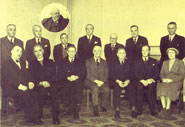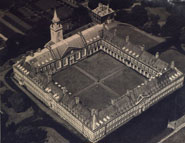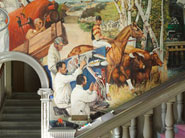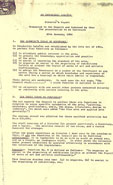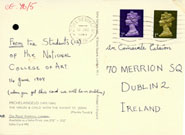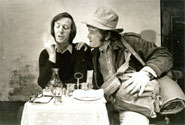The Arts Council in the 1950s
Mr Pat Cooke
UCD School of Art History & Cultural Policy
The stereotypical image of the 1950s in Ireland is of a bleak time, blighted by economic hardship, cultural isolation and emigration. This is not quite the impression that emerges from a review of the Arts Council’s activities in its first decade of existence. The picture is closer to de Valera’s vision of a land of “frugal comforts”—but comforts nonetheless. Where culture and the arts were concerned, it was a land fairly teeming with amateur and self-help groups and societies, especially in music and drama.
When the Arts Council was launched in 1951 with an all-too frugal budget of £10,000, cultural groups approached it tentatively with modest proposals for sums that revealed a low sense of expectation and entitlement to government support. This was reflected in the Council’s main instrument of support in its early years: the guarantee against loss. Arts and cultural organisations expected to be self-funding and, with good luck, to break even. But equally they ran very high risks of loss; the guarantees helped to cushion that risk and ameliorate the accumulation of deficits. It also helped keep alive vital cultural organisations—such as the Gate Theatre—that would otherwise have drowned in debt.
Under its first director, P.J. Little, the Council’s activities were informed by what would now be called a spirit of access and inclusion. The focus was very much on the audience, not on the artist as producer, as the account here of the Council’s support for the building of multi-purpose halls throughout the country illustrates. By contrast, Gerald Dillon’s spurned request for financial assistance reminds us that the emphasis in the Arts Act (1951) is explicitly on promoting the arts, not on supporting the artist, a policy that did not essentially change till the 1970s.
When Sean O’Faolain became director of the Council in 1956 he brought a new energy and direction to its activities. The Arts Act had stipulated the Council’s ‘counselling’ role as a passive one—it could advise the government on arts matters when invited to do so. An independent-minded practicing artist, O’Faolain asserted the independence of the Council and bolstered its advisory role. In the absence of a Heritage Council (thirty years in the future), the Arts Council in the 1950s had a broad conception of its advisory role, embracing heritage and the aesthetics of environment. Thus, in October 1956 it complained about the substitution of modern for lantern cowls on the lamps on O’Connell Bridge, and a little later about the spread of unsightly billboards along the country’s roads.
O’Faolain pushed the Council towards a greater emphasis on aesthetic excellence and high standards. This could result in actions that were both patrician and patronising. In 1959 the director, accompanied by Council member Michael Scott, visited the annual RHA exhibition to determine which, if any, of the works on show by Irish artists might be eligible for funding under its local authorities joint-purchase scheme. They came away without choosing a single work. This unleashed the fury of the artists on show, among them Sean Keating, who wrote a letter to the Irish Times arguing that local authorities “should be helped to buy what they want, instead of what the Arts Council thinks that they ought to want”. O’Faolain’s reply was uncompromising: “the Arts Council cannot devolute to somebody else their duty…to act as a guide in public taste”.
The early Arts Councils comprised members who, on the whole, saw their role as one of public connoisseurship. The average age of all members of the Council in the 1950s (including its first two directors) was 55. Only one woman, Muriel Gahan, was appointed that decade. One of O’Faolain’s last and most enlightened recommendations before departing the Council in 1959 was that a young, energetic man (of course) under forty be appointed as full-time director. That hope would eventually come to pass in 1975 when Colm O’Brian became director at the relatively tender age of thirty-one. Another decade, another era.
 Pat Cooke, UCD School of Art History & Cultural Policy
Pat Cooke, UCD School of Art History & Cultural Policy
